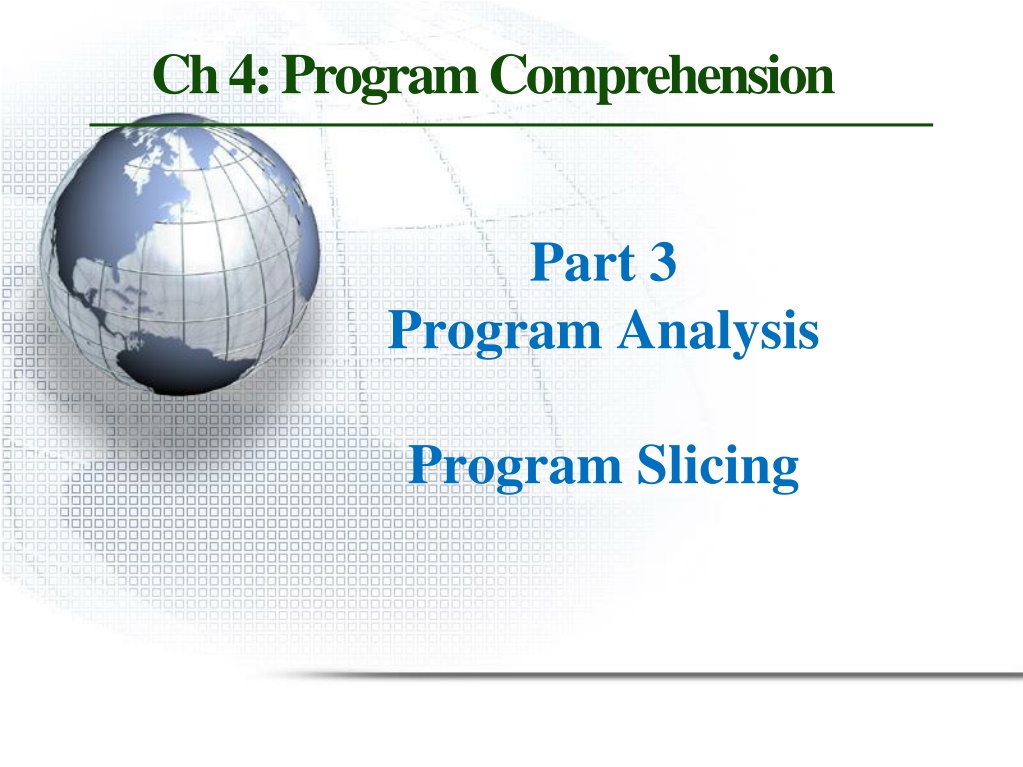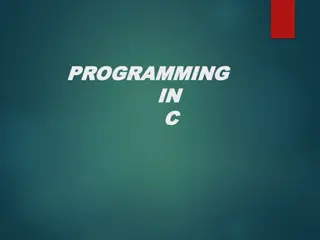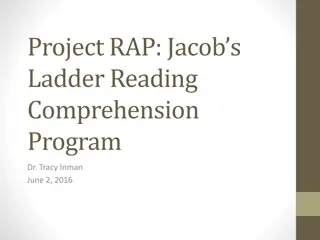Ch 4: Program Comprehension
Program slicing is a technique introduced by Mark Weiser in 1980 that extracts relevant statements from a program based on a specific computation criterion. This technique aids in reducing the complexity of software, making it easier to debug, maintain, and test. Through slicing criteria involving statements and variables, program slices are generated to facilitate program analysis, refactoring, and static slicing.
Download Presentation

Please find below an Image/Link to download the presentation.
The content on the website is provided AS IS for your information and personal use only. It may not be sold, licensed, or shared on other websites without obtaining consent from the author.If you encounter any issues during the download, it is possible that the publisher has removed the file from their server.
You are allowed to download the files provided on this website for personal or commercial use, subject to the condition that they are used lawfully. All files are the property of their respective owners.
The content on the website is provided AS IS for your information and personal use only. It may not be sold, licensed, or shared on other websites without obtaining consent from the author.
E N D
Presentation Transcript
Ch 4: Program Comprehension Part 3 Program Analysis Program Slicing
Outline 1. Introduction 2. Static Slicing 3.Refactoring 2
Introduction The size and complexity of a software today gets harder to understand, maintain and test You might have had questions like: If I change this statement, what pieces of the program are going to be affected? Where are the values that flow into this statement coming from? How can I limit the functionality to only what I need?
Introduction Goals:- - Debug your thousands lines of code easily by reducing the complexity of the program. - Write a robust program before testing your code. - Save your regression testing time by limiting the tests to only those that exercise the changed code.
Introduction How ? - Break larger code into smaller pieces During program design, some known decomposition techniques are -Information hiding and data abstraction Unlike most other methods, slicing is applied to programs after they are written, and is therefore useful in maintenance rather than design
What is program slicing? Program slice is a decomposition technique that extracts statements relevant to a particular computation from a program Program slices was first introduced by Mark Weiser (1980) are known as executable backward static slices Program slicing describes a mechanism which allows the automatic generation of a slice
What is program slicing? Slicing criterion <s , v> - Where s specifies a location (statement s) and v specifies a variable (v) All statements affecting or affected by the variables mentioned in the slicing criterion becomes a part of the slice
What is program slicing? Program slice must satisfy the following conditions - Slice S(V,n) must be derived from P by deleting statements from P - Slice S(V,n) must be syntactically correct - For all executions of P, the value of V in the execution of S(V,n) just before the location n must be the same value of V in the execution of the program P just before location n
Principle of dependences Data dependence -Definition of variable v at statement s1 reaches a use of v at statement s2 Control dependence -Conditional statement controls whether or not the current statement is executed
Program Slicing Extract an executable subset of a program that (potentially) affects the values at a particular program location Slicing criterion = program location + variable An observer focusing on the slicing criterion cannot distinguish a run of the program from a run of the slice 12
Example var n = readInput(); var i = 1; var sum = 0; var prod = 1; while (i <= n) { sum = sum + i; prod = prod* i; i = i + 1; } console.log(sum); console.log(prod);
Example var n = readInput(); var i = 1; var sum = 0; var prod = 1; while (i <= n) { sum = sum + i; prod = prod* i; i = i + 1; } console.log(sum); console.log(prod); Slice for value of sum at this statement?
Example var n = readInput(); var i = 1; var sum = 0; var prod = 1; while (i <= n) { sum = sum + i; prod = prod* i; i = i + 1; } console.log(sum); console.log(prod); Slice for value of sum at this statement?
Example var n = readInput(); var i = 1; var sum = 0; var prod = 1; while (i <= n) { sum = sum + i; prod = prod* i; i = i + 1; } console.log(sum); console.log(prod); Slice for value of prod at this statement
Example var n = readInput(); var i = 1; var sum = 0; var prod = 1; while (i <= n) { sum = sum + i; prod = prod* i; i = i + 1; } console.log(sum); console.log(prod); Slice for value of n at this statement
Why Do We Need Slicing? Various applications, e.g. Debugging: Focus on parts of program relevant for a bug Program understanding: Which statements influence this statement? Change impact analysis: Which parts of a program are affected by a change? What should be retested? Parallelization: Determine parts of program that can be computed independently of each other
Slicing: Overview Forward vs. backward Backward slice (our focus): Statements that influence the slicing criterion Forward slice: Statements that are influenced by the slicing criterion Static vs. dynamic Statically computing a minimum slice is undecidable Dynamically computed slice focuses on particular execution/input
Kinds of program slicing Static slicing using static information(a source program) Dynamic slicing using dynamic information(an execution trace)
Static Program Slicing Various algorithms to compute slices Here: Graph reachability problem based on program dependence graph
Program Dependence Graph Directed graph representing the data and control dependences between statements Nodes: Q Statements Q Predicate expressions Edges: Q Data flow dependences: One edge for each definition-use pair Q Control flow dependences
Variable Definition and Use A variable definition for a variable v is a basic block that assigns to v Q v can be a local or global variable, parameter, or property A variable use for a variable v is a basic block that reads the value of v Q In conditions, computations, output, etc.
Definition-Clear Paths A definition-clear path for a variable v is a path n1,..,nkin the CFG such that n1is a variable definition for v nk is a variable use for v No ni (1 < i k) is a variable definition for v Q nk may be a variable definition if each assignment to v occurs after a use
Definition-Use Pair A definition-use pair (DU-pair) for a variable v is a pair of nodes (d,u) such that there is a definition-clear path d,..,u in the CFG
Data flow dependences: Example
Data flow dependences: Example
Data flow dependences: Example 85
Control Flow Dependences Post-dominator: Node n2(strictly) post-dominates node n1(/= n2) if every path n1, ..., exit in the control flow graph contains n2 Control dependence: Node n2is control-dependent on node n1/= n2if Q there exists a control flow path P = n1,...,n2 where n2 post-dominates any node in P (excluding n1), and Q n2 does not post-dominate n1 17
Control Flow Dependences: Example 1) (strictly) post-dominates 2) Control dependence
Control Flow Dependences: Example 1) (strictly) post-dominates 2) Control dependence
Control Flow Dependences: Example 1) (strictly) post-dominates 2) Control dependence: 6 is Control dependence on 5 7 is Control dependence on 5 8 is Control dependence on 5
Computing Slices Given: Program dependence graph GPD Slicing criterion (n, V ), where n is a statement and V is the set of variables defined or used at n Slice for (n,V): All statements from which n is reachable (i.e., all statements on which n depends) 20
Program Dependence Graph: example 1 2 3 4 5 9 10 6 7 8
Program Dependence Graph: example 1 2 3 4 5 9 10 6 7 8
Program Dependence Graph: example Slice (9, {sum} ) = { n I reachable (n,9)} = {1,2,3,5,6,7,8,9}
Ch 4: Program Comprehension Part 4 Program Analysis Code Refactoring
SOEN 6441 - Advanced Programming Practices 39 Refactoring: what is it? Definition: Refactoring is a disciplined technique for restructuring an existing body of code, altering its internal structure without changing its external behavior. Refactoring does not fix bugs, but it may help find bugs. It may also reduce the further introduction of bugs by cleaning-up code. It is an essential part of agile software development such as Extreme Programming or incremental development. Joey Paquet, 2006-2014
Refactoring Definition: Refactoring modifies software to improve its readability, maintainability, and extensibility without changing what it actually does. External behavior does NOT change Internal structure is improved The goal of refactoring is NOT to add new functionality The goal is refactoring is to make code easier to maintain in the future
SOEN 6441 - Advanced Programming Practices 41 Refactoring: when? Refactoring ought to be done continuously as bad smells are encountered during programming. Bad smells or anti-patterns are portions of design or code that are characterized as potentially confusing and identifies as refactoring targets. More importantly, when using iterative development, a major refactoring stage should precede the beginning of the development of a new build. This will remove slight design problems and ease the addition of further functionality. Joey Paquet, 2006-2014
SOEN 6441 - Advanced Programming Practices 42 Refactoring: why? Refactoring is usually done to: Improve quality improve design quality improve maintainability improve extensibility Improve sustainability of development requires proper testing, so improves testability helps to find bugs Improve productivity improve code readability & comprehensibility simplify code structure Joey Paquet, 2006-2014
Why do good developers write bad software? Requirements change over time, making it hard to update your code (leading to less optimal designs) Time and money cause you to take shortcuts You learn a better way to do something (the second time you paint a room, it s always better than the first because you learned during the first time!)
SOEN 6441 - Advanced Programming Practices 44 Refactoring: how? Each refactoring is implemented as a small behavior-preserving transformation. Behavior-preservation is achieved through pre- and post- transformation testing. Refactoring process: test-refactor-test Joey Paquet, 2006-2014
SOEN 6441 - Advanced Programming Practices 45 Refactoring: drawbacks Cost Overhead: Refactoring is an add-on activity and therefore will incur extra cost in form of time, effort, and resource allocation, especially if elaborated design and code documentation is maintained. However, when done sparingly and only on key issues, its benefits are greater than its overhead. Automated documentation tools, code browsing tools, refactoring tools and testing tools will also diminish the refactoring overhead. Requires Expertise: Refactoring requires some expertise and experience and considerable effort in going through the process, especially if proper testing is involved. However, this overhead can be minimized by using refactoring tools and automated testing such as with a unit testing framework. Joey Paquet, 2006-2014
SOEN 6441 - Advanced Programming Practices 46 Refactoring: examples Consolidate Conditional Expression: You have a sequence of conditional tests with the same result. Refactor by combining them into a single conditional expression and extract it. double disabilityAmount() { if (_seniority < 2) return 0; if (_monthsDisabled > 12) return 0; if (_isPartTime) return 0; // compute the disability amount double disabilityAmount() { if (isNotEligibleForDisability()) return 0; // compute the disability amount Joey Paquet, 2006-2014
SOEN 6441 - Advanced Programming Practices 47 Refactoring: examples Consolidate Duplicate Conditional Fragments: The same fragment of code is in all branches of a conditional expression. Refactor by moving it outside of the expression. if (isSpecialDeal()) { total = price * 0.95; send(); } else { total = price * 0.98; send(); } if (isSpecialDeal()) total = price * 0.95; else total = price * 0.98; send(); Joey Paquet, 2006-2014
SOEN 6441 - Advanced Programming Practices 48 Refactoring: examples Rename Method: The name of a method does not reveal its purpose. Refactor it by changing the name of the method. int getInvCdtLmt(){ } int getInvoiceableCreditLimit(){ } Joey Paquet, 2006-2014
SOEN 6441 - Advanced Programming Practices 49 Refactoring: examples Pull Up Field: Two subclasses have the same field. Refactor it by moving the field to the superclass. Joey Paquet, 2006-2014
SOEN 6441 - Advanced Programming Practices 50 Refactoring: examples Push Down Method: Behavior on a superclass is relevant only for some of its subclasses. Refactor it by moving it to those subclasses. Joey Paquet, 2006-2014























